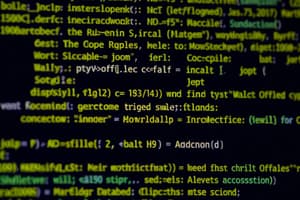Podcast
Questions and Answers
An algorithm is a process or set of rules to be followed in calculations or problem-solving operations.
An algorithm is a process or set of rules to be followed in calculations or problem-solving operations.
True (A)
Pseudocode is an actual programming language.
Pseudocode is an actual programming language.
False (B)
Pseudocode involves using complex sentences and technical jargon.
Pseudocode involves using complex sentences and technical jargon.
False (B)
The pseudocode for computing the area of a rectangle involves adding the length and width.
The pseudocode for computing the area of a rectangle involves adding the length and width.
An algorithm should have well-defined inputs and outputs.
An algorithm should have well-defined inputs and outputs.
An algorithm should not end up in an infinite loops
An algorithm should not end up in an infinite loops
An algorithm must be complex and contain advanced technology to be effective.
An algorithm must be complex and contain advanced technology to be effective.
Algorithms must be just plain instructions that can be implemented in any language,.
Algorithms must be just plain instructions that can be implemented in any language,.
Clarity and unambiguity are essential characteristics of an algorithm.
Clarity and unambiguity are essential characteristics of an algorithm.
Algorithms should be designed without considering the constraints of the problem.
Algorithms should be designed without considering the constraints of the problem.
In Algorithm the problem is broken down into smaller pieces
In Algorithm the problem is broken down into smaller pieces
The first step of the algorithm to add 3 numbers is to print the sum.
The first step of the algorithm to add 3 numbers is to print the sum.
Flashcards
Algorithm
Algorithm
A set of rules or instructions for solving a problem step-by-step.
Algorithm Example
Algorithm Example
A step-by-step procedure leading to a desired outcome, like cooking a dish.
Pseudocode
Pseudocode
Plain English description of a program's steps before coding it in a language.
Pseudocode Use
Pseudocode Use
Signup and view all the flashcards
Algorithm in Programming
Algorithm in Programming
Signup and view all the flashcards
What does pseudocode help with?
What does pseudocode help with?
Signup and view all the flashcards
Add two numbers pseudocode
Add two numbers pseudocode
Signup and view all the flashcards
Enter two numbers in pseudocode
Enter two numbers in pseudocode
Signup and view all the flashcards
Compute area pseudocode
Compute area pseudocode
Signup and view all the flashcards
Print Sum pseudocode
Print Sum pseudocode
Signup and view all the flashcards
Clear and Unambiguous Algorithm
Clear and Unambiguous Algorithm
Signup and view all the flashcards
Well-Defined Inputs
Well-Defined Inputs
Signup and view all the flashcards
Well-Defined Outputs
Well-Defined Outputs
Signup and view all the flashcards
Finite Algorithm
Finite Algorithm
Signup and view all the flashcards
Feasible Algorithm
Feasible Algorithm
Signup and view all the flashcards
Algorithm Steps
Algorithm Steps
Signup and view all the flashcards
Algorithm Advantage
Algorithm Advantage
Signup and view all the flashcards
Why Design an Algorithm?
Why Design an Algorithm?
Signup and view all the flashcards
Constraints in Algorithm Design
Constraints in Algorithm Design
Signup and view all the flashcards
Algorithm Output
Algorithm Output
Signup and view all the flashcards
Problem to solve
Problem to solve
Signup and view all the flashcards
Input
Input
Signup and view all the flashcards
Output
Output
Signup and view all the flashcards
Constraints
Constraints
Signup and view all the flashcards
Solution
Solution
Signup and view all the flashcards
Declare a Variable
Declare a Variable
Signup and view all the flashcards
Take Input
Take Input
Signup and view all the flashcards
Store the Result
Store the Result
Signup and view all the flashcards
What does 'sum' represent?
What does 'sum' represent?
Signup and view all the flashcards
What does 'print sum' do?
What does 'print sum' do?
Signup and view all the flashcards
Study Notes
Algorithm Definition
- An algorithm is a process or set of rules for calculations or problem-solving.
- It's a set of instructions for completing a task to get a specific outcome.
Algorithm Example
- Cooking a recipe is similar to an algorithm.
- Instructions are followed sequentially to achieve the desired result (cooked dish).
- Algorithms in programming also achieve desired output step-by-step.
Pseudocode Explanation
- Pseudocode is an English-like representation of programming code.
- It's not a real programming language.
- It uses short phrases to outline program logic before creating the actual code.
Studying That Suits You
Use AI to generate personalized quizzes and flashcards to suit your learning preferences.
Description
This quiz covers the basics of algorithms, including their definition, importance, and connection to problem-solving. It also explains pseudocode and its role in outlining program logic. Test your understanding of these fundamental programming concepts.




